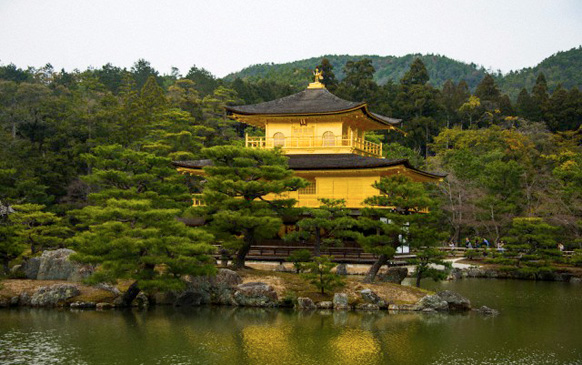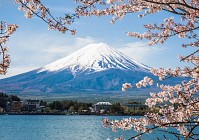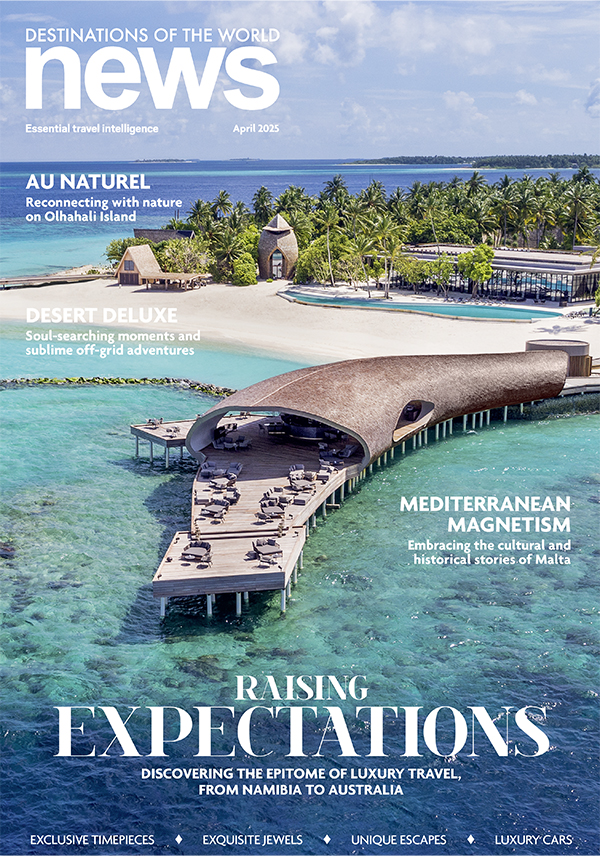The monk sits cross-legged on the ground. We’re in a sparsely furnished room that looks out onto a pretty Zen garden with a small stream and neatly pruned trees. “There’s no goal, no aim,” says the monk, Reverend Toryo Ito, introducing me to the Zen concept. “It’s just about sitting. Here, now.”
We’re in Ryosoku-in, a sub-temple of Kennin-ji, the oldest Zen temple in Kyoto. Zen means ‘meditation’ and ‘Zazen’ (seated meditation) is at the heart of Zen Buddhism, which is more of a philosophy than a religion. “It’s a philosophy of trusting the human being, not a god,” as Rev. Ito succinctly puts it. “The simplest way to describe it is to be natural with the moment; to be present.”
Kyoto is one of the best places in Japan to explore and learn about Zen. The city was, for a little more than 1,000 years (794–1868 AD), the capital of Japan. Kyoto is still seen by many as the spiritual, cultural and historical heart of Japan, not least because it’s the original home of the famous geishas (or geiko, as they’re locally known), as well as about 1,600 Buddhist temples and 400 Shinto (Japan’s other traditional religion) shrines across the city.

Zen in Japan breaks down into three sects or schools: Rinzai, Soto and Obaku. Soto is the largest, but most of Kyoto’s Zen temples are Rinzai. I visit several of the major ones with local guide, Mie Tamada. Buddhism has existed in Japan since at least 538 AD, she tells me. Zen Buddhism was brought to Japan by priest, Yosai (also written as ‘Eisai’), from China, where he studied.
He also brought green tea with him, which is drunk in traditional tea ceremonies. In 1202 AD, Yosai established Kennin-ji on the edge of the geisha district of Gion. There are approximately 85 million Buddhists in Japan today — about two-thirds of the country’s population. Many Japanese people are followers of Shinto or Buddhism, or a combination of both. For Zen practitioners, meditation is a useful tool. “People live in a very busy world,” says Tamada. “So they have to stop and think about the meaning of their life sometimes.”
Many Japanese people, though, aren’t particularly religious, choosing to visit a temple at New Year and pray for good luck and happiness, rather than actively follow a religion year round. Zen is more of a cultural tradition than a set of supernatural beliefs; a central part of Japanese culture. “Zen has exerted tremendous influence on every aspect of Japanese culture, including tea ceremonies, art, flower arrangement, cuisine, martial arts and landscape gardening,” says Tamada. “Zen is in the Japanese DNA and in Japanese people’s way of thinking.”
Zen is also evident in Japanese design and taste, favouring simplicity and understated refinement over anything gaudy or ostentatious. Our first stop is the 700-year-old Daitoku-ji. We enter Zuiho-in, one of the 22 sub-temples in the monastery complex, where Tamada talks me through the Garden of Solitary Sitting, a good example of a typical Zen garden, with features including a stone lantern, neat pine trees, rocks and, rather than grass and flowers, gravel that’s been carefully raked to give the impression of water. Zen gardens were developed as an aid to meditation. “The elements have meaning, but they’re open to interpretation,” Tamada explains. “A garden is not to look at and admire, but [a way] to look at our self, for reflection.”
We move on to the nearby Kinkaku-ji (or Rokuon-ji) temple, better known to tourists as the Golden Pavilion. The UNESCO World Heritage Site was rebuilt in 1955 after the original burned down. A key feature is its central temple, which is covered in gold leaf. It was originally built as a retirement villa by Shogun Ashikaga Yoshimitsu, displaying his wealth and power, but was turned into a Zen temple later, which explains why the design doesn’t keep with the Zen philosophy of simplicity. Across the city at Nanzen-ji, Tamada points out the basic feel of the main temple compared to sacred buildings in Christianity and other religions. “In Zen, the most important thing is the practice, the meditation. Nothing else.”

We end the day back at Kennin-ji on the edge of Gion. After 25 minutes sitting silently, timed using the burning of fragrant incense sticks, Rev. Ito dispells a few inaccurate impressions of Zen, including the idea you need to ‘empty’ your mind. “‘Empty’ is a word in many magazine articles about Zen. But it’s not a perfect translation for Zen. Everything flows through your mind like a river and you let it flow and let it go.”
What’s learned in meditation crosses over into daily life. “In daily life, we care about our future too much. And about our past. We don’t live now. We look for the meaning of everything too much. After learning just sitting, we can also learn just working, just standing, just being with others.”
Many people have heard of enlightenment. “We often say ‘awakened’,” Ito offers instead. “Buddha was ‘the awakened one’. You can understand impermanence in your mind, but in daily life, you can’t feel it. When awakened, we can live according to this ‘impermanence’ philosophy. It gives contentment. It’s a good way to live.”
MODERN AWAKENING
These kinds of one-on-one experiences with Zen monks aren’t commonly open to the public; my visit was arranged by The Ritz-Carlton Kyoto, the newest luxury hotel in the city. It would be going too far to call the hotel ‘Zen’, as it’s too luxurious, but the self-described ‘urban resort’ is designed according to the Japanese miyabi aesthetic, favouring elegance and refinement above opulence. It’s located in the heart of downtown Kyoto, a 15-minute walk from Gion, but feels peaceful and quiet inside. Rooms are spacious, with big bathrooms decorated with Japan’s famous cherry blossoms and views of the Kamogawa River and the mountains beyond the city.
Keen to continue feeling a Zen-like sense of contentment, I head down to the hotel’s spa to try out its signature treatment, the Ryokucha Serenity Ritual. After a foot rub and scrub, I’m given a gentle pummelling with hot poultices containing green tea and lemongrass, followed by an expert body and head massage.
Zen vibes continue at the hotel’s two restaurants.La Locanda delivers fine Italian cuisine and features a chic mahogany bar, a 360-degree wine cellar and a Zen garden at its centre, complete with a stone lantern, raked gravel and bamboo. Meals here end with desserts from France’s Pierre Hermé, who also has a shop in the lobby selling macaroons and cakes. His food crops up again at the breakfast buffet. The hotel’s other restaurant, Mizuki, is Japanese, with sushi and tempura counters, a kaiseki (multi-course) menu featuring top quality dishes including sashimi and crispy tempura, and a Chef’s Room serving teppanyaki. The elegant dining room looks out onto a small waterfall and rock garden.

There are other more traditional places to stay in Kyoto, too. Yoshida Sanso, east of downtown, was built in 1932 to serve as the second residence of Prince Higashi-Fushimi, the uncle of the current Emperor of Japan. Members of the royal family still visit, as, I’m told, do monks and Zen masters. There are only five rooms or cottages here, making a stay exclusive and private; a chance to enjoy the warm hospitality of mother and daughter Kyoko and Tomoko Nakamura. Rooms are welcoming and quite minimalist, with tatami (traditional mats), sliding doors and traditional artworks. This is also one of the best places in Kyoto to come for lunch. Kaiseki meals are served course by course in a private dining room looking out onto the peaceful garden. The food is light, healthy and presented with care and immaculate detail: from sesame tofu and beetroot, to squid, tuna and red snapper sashimi, and miso soup, all washed down with a jug of smooth sake.
Hiiragiya (Holly House) is even older, having opened in 1818. Like Yoshida Sanso, it’s built along the lines of a ryokan (traditional Japanese inn). There’s an impressive modern wing, but really it’s the slice of classic Japan that you come for. On the way in, I’m shown the small room where Charlie Chaplin experienced a tea ceremony. I stay in Room 14, a favourite of Japan’s first Nobel laureate for literature, Yasanari Kawabata.
It’s easy to see why. It’s spacious and classic Japanese, with tatami, painted screen doors and a big wooden bath tub, and is surrounded by it’s own secluded garden. After another fantastic kaiseki dinner, I explore the streets of Pontocho, Gion and Shimbashi, which look as though they also haven’t changed in decades.
To complete my tour of the different accommodation styles available in Kyoto, I also stay in a modern take on the ryokan, Hoshinoya, which is a short boat ride up the Oigawa River from Togetsukyo Bridge, close to the city’s famous bamboo forests. Two gardens at the ryokan are designed according to Zen principles to give the effect of flowing water. There are only 25 rooms here, each looking out onto the river. Mine has two levels, the upper level kitted out with a bed and equipment for an in-room, 90-minute acupuncture and massage treatment.
The Hoshinoya staff arrange an early visit to Daitoku-ji to experience morning worship. I leave before 5am and arrive as the first light is appearing in the sky. Rev. Shodo Maeda, the abbot of the temple, chants and beats a rhythm on gongs and a drum shaped like a fish. Afterwards, we sit in silent meditation, then move to a small room where he serves green tea in a ritualised ceremony. “Like Mount Fuji, there are many points to start,” Rev. Maeda tells me. “But the peak is the same. The peak is awakening the self. The peak is to know more about yourself, so you can realise more in daily life; to awake yourself and to make yourself better every day.”
THE GOLDEN BOOK
Hiiragiya
Tel: +81 75 221 1136
www.hiiragiya.co.jp
Hoshinoya Kyoto
Tel: +81 503 786 0066
global.hoshinoresort.com
Nakamura
Tel: +81 75 221 5511
www.kyoryori-nakamura.com
The Ritz-Carlton, Kyoto
Tel: +81 75 746 5555
www.ritzcarlton.com
Yoshida Sanso
Tel: +81 75 771 6125
www.yoshidasanso.com


















